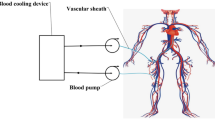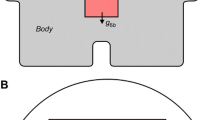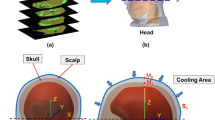Abstract
Therapeutic hypothermia has been the most effective therapy to treat serious cardiovascular and cerebrovascular diseases. Among them, intravascular cooling is identified as a most efficient approach to induce brain hypothermia. However until now, some key parameters and temperature management method for intravascular cooling are still not well addressed because of the complexity of human thermoregulation mechanism. Aiming at predicting temperature variation of tissues and organs in a more accurate way during therapeutic hypothermia, this study is dedicated to integrate the blood flow model in the circle of Willis together with the compartmental model for characterizing the heat and blood transport throughout the whole human body. According to the theoretical evaluation, the new model could well simulate the temperature response of the whole human body especially the brain under various cooling. Effects of different intervention site and cooling power to the hypothermia performance are discussed, which shows that carotid artery intervention is a more suitable therapeutic hypothermia method in comparison with femoral artery or femoral vein intervention. These results could help design controlling software for intravascular therapeutic hypothermia device in the near future.
Similar content being viewed by others
Abbreviations
- c :
-
Heat capacity (kJ/kg K)
- D :
-
Vessel diameter (m)
- h :
-
Convection coefficient (W/m2 K)
- Q :
-
Flow (m3/s)
- k :
-
Thermal conductivity (W/m K)
- L :
-
Vessel length (m)
- P :
-
Pressure (Pa)
- \(\dot{Q} _{\mathit{cond}}\) :
-
Conductive heat transfer rate (W)
- \(\dot{Q} _{\mathit{evap}}\) :
-
Heat loss by evaporation (W)
- \(\dot{Q}_{\mathit{in}}\) :
-
Cooling power (W)
- \(\dot{Q}_{\mathit{rad}}\) :
-
Radiative heat transfer rate (W)
- \(\dot{Q}_{\mathit{resp}}\) :
-
Heat loss by respiration (W)
- \(\dot{Q}_{\mathit{met}}\) :
-
Metabolic heat production (W)
- R e :
-
Effective conduction resistance (m K/W)
- V :
-
Volume (m3)
- ε :
-
Surface emissivity
- μ :
-
Dynamic viscosity of blood (kg/m K)
- ρ :
-
Density (kg/m3)
- σ :
-
Stefan-Boltzmann constant (W/m2 K4)
- ω b :
-
Basic perfusion rate (ml/min 100 g)
- ACA:
-
Anterior cerebral artery
- ACoA:
-
Anterior communicating artery
- BA:
-
Basilar artery
- ICA:
-
Carotid artery
- MAP:
-
Mean arterial pressure
- MCA:
-
Middle cerebral artery
- PCA:
-
Posterior cerebral artery
- PCoA:
-
Posterior communicating artery
- B:
-
Blood
- L:
-
Left
- R:
-
Right
References
Polderman KH (2003) Application of therapeutic hypothermia in the intensive care unit. J Intensive Care Med 30:757–769
Safar PJ, Kochanek PM (2002) Therapeutic hypothermia after cardiac arrest. N Engl J Med 347:63–65
Nolan JP, Deakin CD, Soar J et al. (2005) European Resuscitation Council guidelines for resuscitation. Resuscitation 67:S39–S86
Nolan JP, Morley PT, Hoek TL et al. (2003) Therapeutic hypothermia after cardiac arrest: an advisory statement by the Advancement Life Support Task Force of the International Liaison Committee on Resuscitation. Resuscitation 108:118–121
Liu J (2007) Cooling strategies and transport theories for brain hypothermia resuscitation. Front Energy Power Eng Chin 1:32–57
Diller KR, Zhu L (2009) Hypothermia therapy for brain injury. Annu Rev Biomed Eng 11:135–162
Pennes HH (1948) Analysis of tissue and arterial blood temperatures in the resting human forearm. J Appl Physiol 1:93–122
Ji Y, Liu J (2002) Numerical studies on the effect of lowering temperature on the oxygen transport during brain hypothermia resuscitation. Comput Biol Med 32:495–514
Diao C, Zhu L, Wang H (2003) Cooling and rewarming for brain is chemia or injury: theoretical analysis. Ann Biomed Eng 31:346–353
Neimark MA, Konstas A, Choi JH, Laine AF, Pile-Spellman J (2008) Brain cooling maintenance with cooling cap following induction with intracarotid cold saline infusion: a quantitative model. J Theor Biol 253:333–344
Janssen FEM, Van Leeuwen GMJ, Van Steenhoven AA (2005) Modeling of temperature and perfusion during scalp cooling. Phys Med Biol 50:4065–4073
Ley O, Bayazitoglu Y (2003) Effect of physiology on the temperature distribution of a layered head with external convection. Int J Heat Mass Transf 46:3233–3241
Bommadevera M, Zhu L (2002) Temperature difference between the body core and the arterial blood supplied to the brain during hyperthermia or hypothermia in humans. Biomech Model Mechanobiol 1:137–149
Zhu L (2000) Theoretical evaluation of contributions of both radial heat conduction and countercurrent heat exchange in selective brain cooling in humans. Ann Biomed Eng 28:269–277
van Leeuwen GMJ, Hand J, Lagendijk JW, Azzopardi V, Edwards AD (2000) Numerical modeling of temperature distributions within the neonatal head. Pediatr Res 48:351–356
Moorhead KT, Doran CV, Chase JG, David T (2004) Lumped parameter and feedback control models of the auto-regulatory response in the circle of Willis. Comput Methods Biomech Biomed Eng 7:121–130
Ferrandez A, David T, Brown MD (2002) Numerical models of auto-regulation and blood flow in the cerebral circulation. Comput Methods Biomech Biomed Eng 5:7–19
Cebral JR, Castro MA et al. (2003) Blood-flow models of the circle of Willis from magnetic resonance data. J Eng Math 47(3–4):369–386
Matthew AN, Angelos AK, Andrew FL, John PS (2007) Integration of jugular venous return and circle of Willis in a theoretical human model of selective brain cooling. J Appl Physiol 103:1837–1847
Xiang SH, Liu J (2008) Comprehensive evaluation on the heating capacities of four typical whole body hyperthermia strategies via compartmental model. Int J Heat Mass Transf 51:5486–5496
Ferreira MS, Yanagihara JI (2009) A transient three-dimensional heat transfer model of the human body. Int Commun Heat Mass Transf 36:718–724
Alastruey J, Parkerb K, Peiro J, Byrdc SM, Sherwin SJ (2007) Modeling the circle of Willis to assess the effects of anatomical variations and occlusions on cerebral flows. J Biomech 40:1794–1805
Tanaka HN, Fujita T, Enoki K et al. (2006) Relationship between variations in the circle of Willis and flow rates in internal carotid and basilar arteries determined by means of magnetic resonance imaging with semiautomated lumen segmentation: reference data from 125 healthy volunteers. Am J Neuroradiol 27:1770–1775
Sempere AF (2000) Computational models of blood flow in the circles of Willis. Diploma thesis, University of Leeds
Wikipedia, the free encyclopedia. http://en.wikipedia.org/wiki/Hagen%E2%80%93Poiseuille_equation
Chen Z, Yuan Q, Shen N, Cui CC, Yong Z (2008) 3-Dimensional steady/unsteady blood flow in the circle of Willis. Acad J XJTU 42:492–496
Matthew AN, Angelos AK, Andrew FL, John PS (2007) Integration of jugular venous return and circle of Willis in a theoretical human model of selective brain cooling. J Appl Physiol 103:1837–1847
Yue K, Luo YH, Zhang XX (2010) Analysis on temperature distribution during local cooling with consideration of cerebrospinal fluid. J Basic Sci Eng 18:484–492
Gordon G, Roemer R, Horvath SM (1976) A mathematical model of the human temperature regulatory system-transient cold exposure response. IEEE Trans Biomed Eng 23:434–444
Fanger PO (1972) Thermal comfort: analysis and applications in environment engineering. McGraw Hill, New York
Moore S, David T, Chase JG, Arnold J, Fink J (2006) 3D models of blood flow in the cerebral vasculature. J Biomech 39:1454–1463
Alnæs MS, Isaksen J et al. (2007) Computation of hemodynamics in the circle of Willis. Stroke 38:2500–2505
Wissler EH (1998) Pennes’ 1948 paper revisited. J Appl Physiol 85:35–41
Author information
Authors and Affiliations
Corresponding author
Rights and permissions
About this article
Cite this article
Xue, X., Liu, J. Multi-scale modeling on human intravascular cooling to induce brain hypothermia via circle of Willis. Forsch Ingenieurwes 75, 257–269 (2011). https://doi.org/10.1007/s10010-011-0148-1
Received:
Published:
Issue Date:
DOI: https://doi.org/10.1007/s10010-011-0148-1




